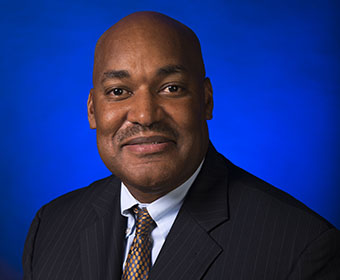Q&A with Gerald Lewis, UTSA chief of police and AVP of public safety

As Chief of Police, Gerald Lewis is responsible for the safety of more than 35,000 UTSA students, faculty, staff and visitors.
(April 24, 2017) -- His infectious smile and grand stature are hard to miss as he walks across The University of Texas at San Antonio (UTSA) campuses chatting with students. Gerald Lewis, now in his 30th year of law enforcement, serves as the UTSA associate vice president of public safety and chief of police.
It's been nearly a year since Lewis joined UTSA. Prior to becoming a Roadrunner, Lewis served as chief of police at East Carolina University for two-and-a-half years and oversaw public relations and minority recruitment for the New Jersey State Police for 26 years.
Recently, we sat down with Lewis, who is approaching his nine-month anniversary at UTSA. He was eager to share his initial impressions of San Antonio's top-tier university.
How did the opportunity to join UTSA transpire?
I was at East Carolina and I had a great two-and-a-half years there. We did a lot of innovative things. But I saw the posting for the job at UTSA on the International Association of Chiefs of Police website and I thought, 'Wow, San Antonio sounds like an interesting place.'
I did some research. I learned about the diversity at UTSA and how young the university was. That intrigued me. I knew UTSA would be a place where I could grow further as a police officer and as an administrator. I applied and went through the interview process. I came to campus for a selection process and was subsequently offered the position.
A big selling point was that the UTSA Police Department has ACLEA and IACLEA certifications. These certifications are offered by two international sanctioning bodies in law enforcement, and they're the best of the best. When I saw that UTSA had these certifications, I knew that its police department followed best practices and procedures in law enforcement. That was also very attractive.
Why did you get into law enforcement?
It's an interesting story.
I was an all-state caliber basketball player in high school. I was fortunate enough to earn a basketball scholarship to Wagner College on Staten Island where I played under P.J. Carlesimo. He later became an assistant coach for the Spurs. When I went to Wagner, I discovered that I probably wasn't going to play pro basketball.
One day, a friend told me about a state police test would be given on Saturday. I'd been interested in becoming a police officer, so I had to make a choice. Was I going to go to basketball practice or was I going to take the police exam? I looked at longevity. I could do this police thing for 25 years. Basketball was probably not going to last that long. I took the police exam that day and ended up getting cut from the basketball team. It was one of the best moves I ever made.
After 26 years with the New Jersey State Police, why the switch to higher education?
I enjoy variety and after 26 years I was looking at other jobs in New Jersey. I had done some work with a friend on minority recruitment, in particular with the NAACP to increase awareness of minority recruitment with New Jersey State Police. He told me about a job with East Carolina University. He was on the search committee. I was drawn by the opportunity to take on a new challenge.
He asked me if I thought I could get my wife to move to Eastern North Carolina. I actually have family there, so I told him, "I think I can pull that off."
It was a national search that consisted of many interviews and social events. Just before Thanksgiving 2013, they offered me the position.
What was the best part of your job at ECU?
I loved being around the students, and I loved being around young people. It really gave me the opportunity to not only share my law enforcement experience, but share some of my social skills and do more community outreach geared toward youth. That was exciting to me. It was new and different, but I was able to bring some of my skills and experiences from working for state police to university policing. It was a good marriage.
Tell us about your vision for UTSA.
I don't have enough words to describe my vision for the UTSA Police Department. We have outstanding personnel, and I want to make sure we help everyone reach their potential.
As far as safety, my focus is on preventing active shooters and other types of campus violence. Our students, faculty, staff and visitors deserve a safe university and workplace. I will do everything within my power to keep our campuses safe.
In my initial time at UTSA, I've done quite a bit of community outreach. But I'm eager to do more outreach on and off campus. I want to develop even stronger relationships between our department and San Antonio area police departments, as well as state and federal agencies.
The prevention of sexual assault is also a priority for me. I take that personally as the father of two young women. I try to put myself in the shoes of a mother or father who has sent their most valuable commodities somewhere. They're trusting me to keep them safe.
I also want to do more with technology. We have a lot of opportunities available to us that would allow us to stay connected to the campus community. We need to incorporate more technology into our day-to-day operations.
I work for the best supervisor of my career in Kathy Funk-Baxter, the vice president for business affairs. She's given me the ability to be successful and she's given me flexibility. I think it's already paying off in some of the things we're doing.
Living your entire life on the east coast, what's your impression of San Antonio?
I love it, and I love it for my family. My wife has adapted very well and, of course, happy wife, happy life.
I have an 11-year-old son who has thrived here and made a lot of new friends.
There's so much to do here. I don't think you can find a better place to raise your family.
I think people have this misconception of Texas that there's tumbleweeds rolling down the street and people still park their horses. This is a great city. It's innovative. I'm at a point now where I want people to visit me so I can destroy all the misconceptions they have of Texas.
What do you want to be known for at UTSA?
The most important thing I want to be known for is approachability. I will meet with anyone to help solve any kind of problem. For example, when I first started at UTSA, there was an instance last fall where we heard there was going to potentially be a protest on campus. I spoke to the people who planned to protest prior to their event. I wanted there to be a dialogue. They deserved that.
When we had move-in day, I helped move people in, and I greeted parents and assured them that I was going to do everything I could to make sure their children would be safe. I think that resonates with a lot of people. I hope it rubs off on our officers to be more engaged. My goal is to protect our safe learning environment.
What do you like to do for fun?
I like to read. I love music. Music is a huge influence in my life. I like all types of music. If I turned my phone on now, you'd hear the Fabulous Thunderbirds, U2, Marvin Gay.
And I still play basketball. I don't jump as high as I used to. I'm not quick at all, but I can still score.
-------------------------------
Learn more about Gerald Lewis.
Learn how the UTSA Police Department is keeping you safe.
Connect with UTSA online at Facebook, Twitter, YouTube, Instagram and LinkedIn.
Events
Día en la Sombrilla, formerly Fiesta UTSA, is a festival hosted each spring as a part of Fiesta® San Antonio events. Sponsored by Roadrunner Productions, the event features music, food, confetti, games, event t-shirts, and more.
Sombrilla Plaza, Main CampusCovidence is a systematic & scoping review tool used to streamline the process of screening and reviewing articles. Using this software, research teams can easily import studies, perform automatic deduplication, and extract data using templates. This workshop will show attendees how to start a review in Covidence, add collaborators, and get started on screening.
Virtual (Zoom)In this workshop, attendees will be introduced to Pandas, a Python tool for working with data easily. It makes it simple to organize and analyze information when data is organized and categorized, like spreadsheets or tables.
Group Spot B, John Peace LibraryEach fall and spring semester, students convene at the Main Campus at UTSA with booths, ideas and prototypes. A crowd of judges, local organizations, students, faculty and sponsors walk around and talk to the students about their projects and ask questions. Students get the real-life experience of "pitching" their project with hopes of getting funding or support to move to the next level.
UTSA Convocation Center, Main CampusJoin the doctoral candidates for the Doctoral Conferreal Ceremony and celebrate their accomplishments.
Arts Building Recital Hall, Main CampusCelebrate the graduates from the Carlos Alvarez College of Business, College of Education and Human Development, Margie and Bill Klesse College of Engineering and Integrated Design and University College.
AlamodomeCelebrate the graduates from the College for Health, Community and Policy, College of Liberal and Fine Arts and College of Sciences.
Alamodome

